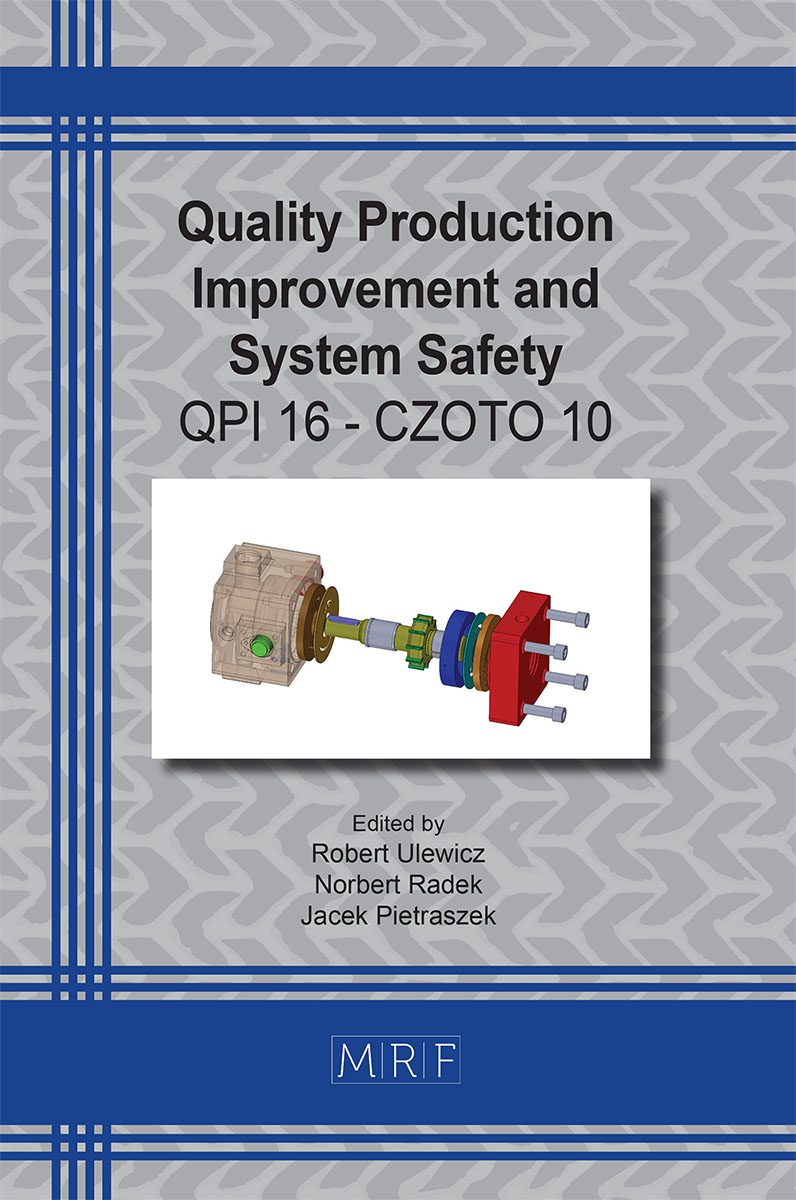Effect of Impregnation of Activated Carbon with Selected Transition Metal Ions on Its Adsorption Properties and Pore Size
POSZWALD Bartosz, KWAK Anna, DYSZ Karolina, DYLONG Agnieszka
download PDFAbstract. Thanks to their vast surface area, activated carbons are materials of great interest. They are used as adsorbents for both liquid- and gaseous impurities. To improve their properties, impregnation with different substances is conducted. In this paper, such an impregnation was done using copper(II), manganese(II), silver(I), and zinc(II) salts. The aim was to compare the inner structure of the impregnated activated carbon with a non-impregnated one. It was done by Brunauer-Emmett-Teller (BET) adsorption-desorption isotherms that were plotted and described. Lastly, the pore size and volume were determined by Barrett-Joyner-Halenda (BJH) method. The results show that the presence of zinc(II) salts helped to develop the mesoporous structure of activated carbon and resulted in an increase in the surface area of the sorbents, while silver(I) decreased it.
Keywords
Activated Carbon, Impregnation, Adsorption Isotherm, BET Method, BJH Method, Transition Metals
Published online 9/1/2023, 8 pages
Copyright © 2023 by the author(s)
Published under license by Materials Research Forum LLC., Millersville PA, USA
Citation: POSZWALD Bartosz, KWAK Anna, DYSZ Karolina, DYLONG Agnieszka, Effect of Impregnation of Activated Carbon with Selected Transition Metal Ions on Its Adsorption Properties and Pore Size, Materials Research Proceedings, Vol. 34, pp 87-94, 2023
DOI: https://doi.org/10.21741/9781644902691-11
The article was published as article 11 of the book Quality Production Improvement and System Safety
![]() Content from this work may be used under the terms of the Creative Commons Attribution 3.0 license. Any further distribution of this work must maintain attribution to the author(s) and the title of the work, journal citation and DOI.
Content from this work may be used under the terms of the Creative Commons Attribution 3.0 license. Any further distribution of this work must maintain attribution to the author(s) and the title of the work, journal citation and DOI.
References
[1] S.J. Chak. Absorption, in: A.D. McNaught, A. Wilkinson (Eds.) IUPAC. Compendium of Chemical Terminology 2nd ed., Blackwell Scientific Publications, Oxford, 1997. https://doi.org/10.1351/goldbook.A00036
[2] Procesy sorpcyjne. Skrypt do ćwiczeń. [online]. 2010. [viewed: 2023-01-25]. Available from: https://www2.chemia.uj.edu.pl/dydaktyka/Procesy_Sorpcyjne.pdf
[3] G. Jozefaciuk, A. Szatanik-Kloc, A. Ambrozewicz-Nita. The Surface area of zeolite-amended soils exceed the sum of the inherent surface areas of soil and zeolites, Eur. J. of Soil Sc. 69(5) (2018) art. 12691. https://doi.org/10.1111/ejss.12691
[4] A. Kumar, H. M. Jena. Adsorption of Cr(VI) from aqueous solution by prepared high surface area activated carbon from Fox nutshell by chemical activation with H3PO4, J. of Env. Chem. Eng. 5(2) (2017) 2032-2041. https://doi.org/10.1016/j.jece.2017.03.035
[5] S. Tripathi, N. Arora, P. Gupta, P.A. Pruthi, K.M. Poluri, V. Pruthi. Microalgae: An emerging source for mitigation of heavy metals and their potential implications for biodiesel production, in: A.K. Azad, M. Rasul, Advanced Biofuels Applications, Technologies and Sustainable Development, Woodhead Publishing, Sawstone, 2019, pp. 97-128.
https://doi.org/10.1016/B978-0-08-102791-2.00004-0
[6] Standardized reporting of gas adsorption isotherms [online]. 2021. [viewed: 2023-01-27]. Available from: https://iupac.org/project/2021-016-1-024
[7] R.J. White, V. Budarin, J.H. Clark, R.Luque. Tuneable porous carbonaceous materials from renewable resources, Chem. Soc. Rev. 38(12) (2009) 3401-3418. https://doi.org/10.1039/b822668g
[8] M. Kajama. Hydrogen permeation using nanostructured silica membranes, Sustainable Development and Planning 2015 (2015), Istanbul, Turkey, 447-456. https://doi.org/10.2495/SDP150381
[9] Carbonology Chemically activated carbon. [online]. 2019. [viewd: 2023-01-29]. Available from: https://www.desotec.com/en/carbonology/carbonology-academy/chemically-activated-carbon
[10] T. Borowiecki, J. Kijeński, J. Machnikowski, M. Ściążko. Czysta energia, produkty chemiczne i paliwa z węgla- ocena potencjału rozwojowego, Wydawnictwo Instytutu Chemicznej Przeróbki Węgla, Zabrze, 2008.
[11] M. Thommes et al. Physisorption of gases, with special reference to the evaluation of surface area and pore size distribution (IUPAC Technical Report), Pure Appl. Chem. 87(9-10) (2015)
1051-1069. https://doi.org/10.1515/pac-2014-1117
[12] B. Jasiewicz et al. Inter-observer and intra-observer reliability in the radiographic measurements of paediatric forefoot alignment, Foot Ankle Surg. 27 (2021) 371-376. https://doi.org/10.1016/j.fas.2020.04.015
[13] J. Pietraszek et al. The parametric RSM model with higher order terms for the meat tumbler machine process, Solid State Phenom. 235 (2015) 37-44. https://doi.org/10.4028/www.scientific.net/SSP.235.37
[14] J. Korzekwa et al. Tribological behaviour of Al2O3/inorganic fullerene-like WS2 composite layer sliding against plastic, Int. J. Surf. Sci. Eng. 10 (2016) 570-584. https://doi.org/10.1504/IJSURFSE.2016.081035
[15] J. Pietraszek, A. Szczotok, N. Radek. The fixed-effects analysis of the relation between SDAS and carbides for the airfoil blade traces. Arch. Metall. Mater. 62 (2017) 235-239. https://doi.org/10.1515/amm-2017-0035
[16] J. Pietraszek. Fuzzy regression compared to classical experimental design in the case of flywheel assembly, LNAI 7267 LNAI (2012) 310-317. https://doi.org/10.1007/978 3 642 29347 4_36
[17] J. Pietraszek. The modified sequential-binary approach for fuzzy operations on correlated assessments, LNAI 7894 (2013) 353-364. https://doi.org/10.1007/978-3-642-38658-9_32
[18] J. Pietraszek et al. Non-parametric assessment of the uncertainty in the analysis of the airfoil blade traces, METAL 2017 – 26th Int. Conf. Metall. Mater. (2017) 1412-1418. ISBN 978 8087294796
[19] J. Pietraszek, L. Wojnar. The bootstrap approach to the statistical significance of parameters in RSM model, ECCOMAS Congress 2016 Proc. 7th Europ. Congr. Comput. Methods in Appl. Sci. Eng. 1 (2016) 2003-2009. https://doi.org/10.7712/100016.1937.9138
[20] J. Pietraszek et al. Challenges for the DOE methodology related to the introduction of Industry 4.0. Prod. Eng. Arch. 26 (2020) 190-194. https://doi.org/10.30657/pea.2020.26.33
[21] P. Jonšta et al. The effect of rare earth metals alloying on the internal quality of industrially produced heavy steel forgings, Materials 14 (2021) art.5160. https://doi.org/10.3390/ma14185160
[22] N. Radek et al. The impact of laser welding parameters on the mechanical properties of the weld, AIP Conf. Proc. 2017 (2018) art.20025. https://doi.org/10.1063/1.5056288
[23] N. Radek et al. Technology and application of anti-graffiti coating systems for rolling stock, METAL 2019 – 28th Int. Conf. Metall. Mater. (2019) 1127-1132. ISBN 978-8087294925
[24] N. Radek et al. Microstructure and tribological properties of DLC coatings, Mater. Res. Proc. 17 (2020) 171-176. https://doi.org/10.21741/9781644901038-26
[25] N. Radek et al. Influence of laser texturing on tribological properties of DLC coatings, Prod. Eng. Arch. 27 (2021) 119-123. https://doi.org/10.30657/pea.2021.27.15












